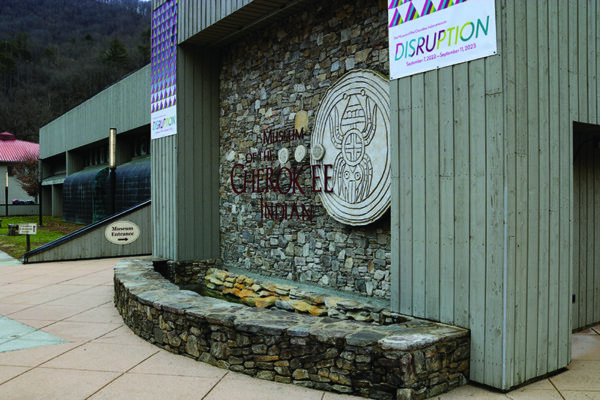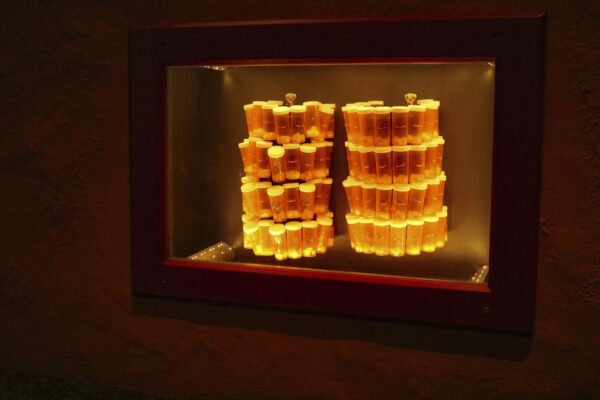By SCOTT MCKIE B.P.
One Feather Asst. Editor
CHEROKEE, N.C. – As the Museum of the Cherokee Indian enters its 75th Anniversary year, its leadership is looking to the future. The Museum was established in 1948 and has been at its current location in the cultural district of Cherokee since 1976.

The Museum of the Cherokee Indian, shown in this photo on the morning of Thursday, Jan. 26, is looking to expand its exhibits and educational opportunities. (SCOTT MCKIE B.P./One Feather photos)
“When I was hired, the Board was interested in redoing the permanent exhibit,” said Shana Bushyhead Condill, a member of the Eastern Band of Cherokee Indians (EBCI) and the Museum’s executive director since June 2021. “We’ve been thinking about what the Museum could be compared to what it is now. The Museum has a long legacy of being innovative. When this building was built in the 1970s, this was cutting edge museum technology.”
The Museum went through its last renovation and changing of the permanent exhibit in 1998. Condill noted, “That renovation blew people away. It was extremely innovative for the 90s with the idea being an immersive experience touching all of your senses with the sound, going through the Trail of Tears section and feeling cold, the lighting – all of that sort of tied into that immersive experience.”
In September 2022, the Museum launched “Disruption” which switched some gears on its permanent exhibit taking funerary and items deemed ceremonial off display. “‘Disruption’ was our way of putting sort of a Band-aid fix on that exhibition. One of the things that we’ve been doing, and will still continue to do as an ongoing project, is speak to different groups about what they’re interested in.”
As the idea of creating a new permanent exhibit goes forward, Condill said she wants to make sure that they’re listening to the wants and concerns of the EBCI tribal members. “One of the things that always comes to mind for me is the timeline way of telling a story is sort of what we expect to see regarding Native representation in museums. And, the thing that keeps coming up over and over again is that it’s more about theme. And a theme that comes up in every conversation is the importance of place. We’re not done having these conversations, but we already know that being of this place is really important to us, as Cherokee people, and we want to make sure that is a theme that runs throughout.”
She further expressed that the idea of place shows itself in many ways from art to historic objects. What we are coming to is that timelines can be useful especially when we’re talking about the formation of the Eastern Band, but not putting our entire story in a timeline is what we’re hoping to do.”
Speaking more on the ‘sense of place’, she said, “That influences our language. It influences our art. It influences our relationships with each other. It is a thread that runs throughout everything.
Condill said when the Museum addresses the Indian Removal Act and others, “What we want all people to understand is that this type of legislation didn’t end in the 1800s. We’re still having battles in the Supreme Court today.”
The concept of “we are still here” is also important she said. “In a natural history museum, you have dinosaur eggs and diamonds, butterflies and then you have Native people. It’s hard not to consider us relics of the past along with all of those things. That’s important for us as well to make sure that we draw a thread to contemporary life. That’s what exciting about ‘Disruption’. It forces you to do that. These artists that are in this exhibition now are all living.”

A piece by Shennelle Feather, entitled “Medicine, Choose How You Use”, is on display in the Museum of the Cherokee Indian’s latest exhibit entitled “Disruption”. Feather’s piece replaces ceremonial Stomp Dance Shakers which were previously on display. The exhibit’s goal was to remove ceremonial and funerary objects that were on display and replace those with artwork from contemporary Cherokee artists.
Condill added, “We are still here. We are so lucky to be on our ancestral homeland. There are lots of tribes that aren’t on their ancestral homeland.”
The current permanent exhibit is around 27,000 square feet with one rotating exhibition space. When she first came on board, Condill noted she thought, “I need more space here to tell more stories. What if we removed our collection storage from this space? It would give more room on this footprint if we had an off-site collections facility.”
And, that is exactly what is going to occur.
Tribal Council approved unanimously Res. No. 145 (2021) on Feb. 3, 2022 that designates “the parcel across Galbraith Creek Road from the current THPO (Tribal Historic Preservation Office) office and across Hwy. 19 (Ela Road) from Kituwah Field in Swain County…be allocated for the Museum of the Cherokee Indian collections/archival facility”.
Samantha Ferguson, Museum board president who submitted the legislation, said in a press release following the legislation being passed, “The MCI Board of Directors is pleased to have completed this next step in the process of constructing an off-site Museum collections and archives facility. We are grateful to Chief Sneed, Vice Chief Ensley, and Tribal Council for their continued support in the development of a state-of-the-art home for the Museum’s objects and paper archives.”
Condill said the need for this facility is urgent. “We have EBCI holdings all over the country that we need to bring home. So, it required another building for sure. We don’t have the storage here.”
She went on to say, “One of the problems that we’ve had is that the HVAV system wasn’t made for a museum and so our collections are suffering. There’s an urgent need for us to move our collections. It’s really hard to control the humidity. That’s reeking a little bit of havoc.”
As for the current Museum building plans, Condill commented, “We’ll take these three acres and rethink it. Of course, we need an engineer to come in and tell me what is worth doing and what the cost is for whatever it is we do. I am dedicated to figuring out a way that we wouldn’t close, at least not for long. That’s a goal… I think our community just wants a place that we can go to where we feel proud of, that is also for us and not just our visitors.”
The simple logistics of walking through the Museum itself is also being looked at during this time of brainstorming ideas for the future of the facility. “For our community, if they want to just pop-in and see the changing exhibition, we want to make sure that it is easily accessible. Right now, you have to walk through the exhibit to get to another side of the building. There’s logistical things that would be nice to clean up in here.”
Condill stresses that no concrete plans have been made. “We’ve been able to do conceptual thinking about it, but we’re nowhere near building plans or anything like that. But, we’re just sort of dreaming big.”





